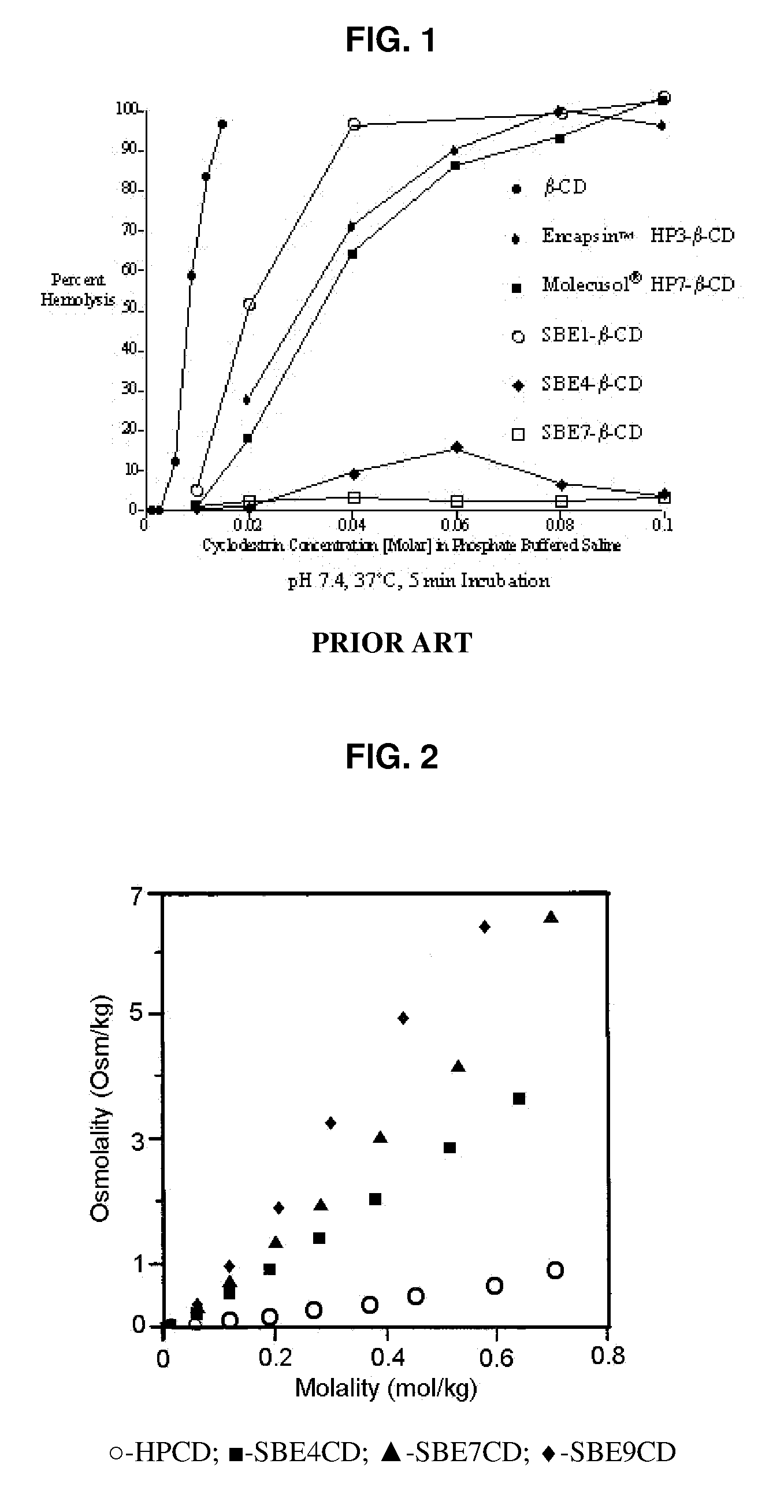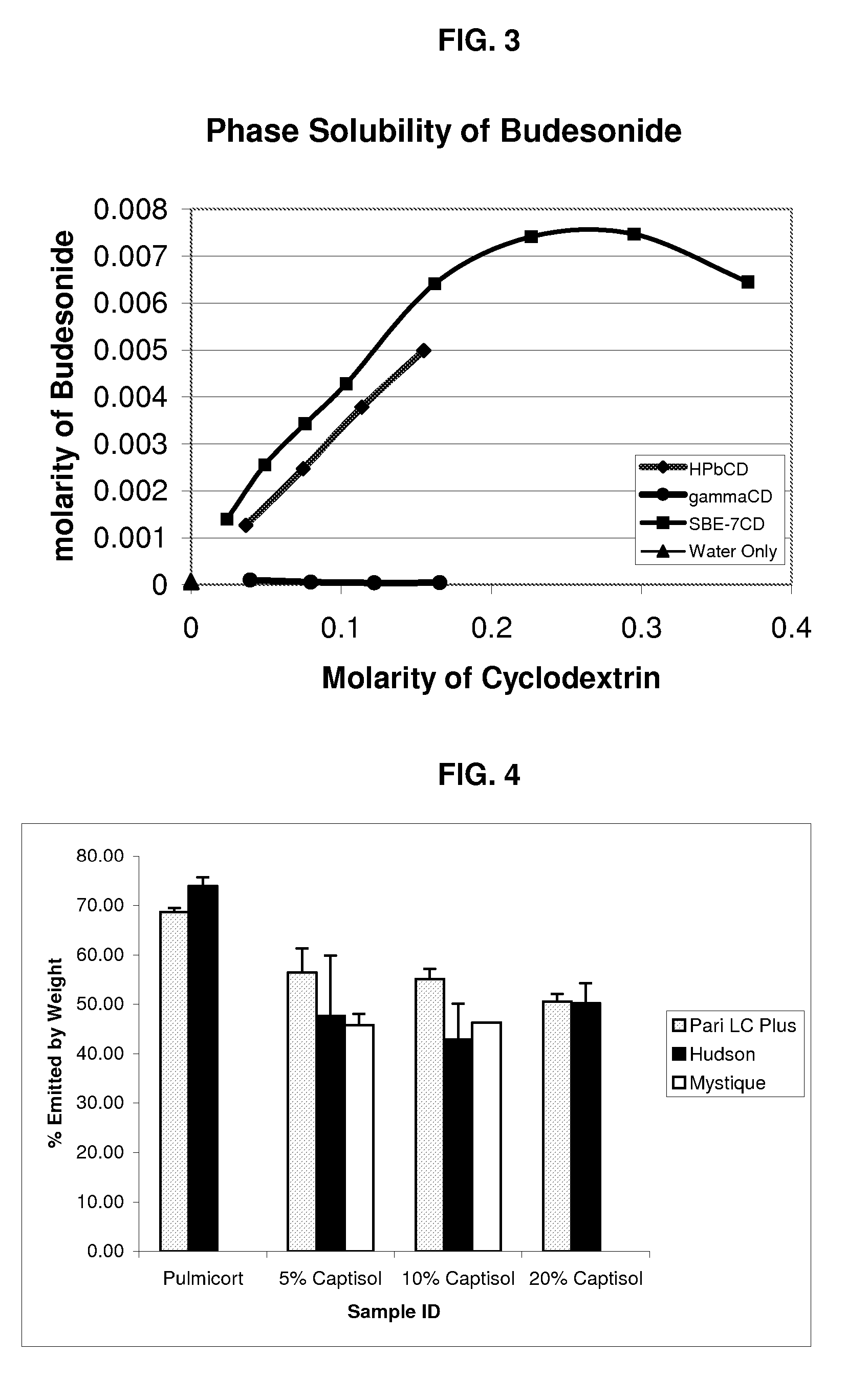Inhalant Formulation Containing Sulfoalkyl Ether Cyclodextrin and Corticosteroid
a technology of sulfoalkyl ether and corticosteroid, which is applied in the field of inhalant formulations containing sulfoalkyl ether cyclodextrin and corticosteroid, can solve the problems of increased cost, inconvenience of needing to prepare medication, and reduced portability, so as to reduce the rate of degradation of corticosteroid, increase the output rate and/or extent of nebulized corticosteroid
- Summary
- Abstract
- Description
- Claims
- Application Information
AI Technical Summary
Benefits of technology
Problems solved by technology
Method used
Image
Examples
example 1
[0328] Exemplary formulations according to the invention were made according to the following general procedures.
Method A
[0329] Cyclodextrin is dissolved in water (or buffer) to form a solution containing a known concentration of cyclodextrin. This solution is mixed with an active agent in solid, suspension, gel, liquid, paste, powder or other form while mixing, optionally while heating to form an inhalable solution.
Method B
[0330] A known amount of substantially dry cyclodextrin is mixed with a known amount of substantially dry active agent. A liquid is added to the mixture to form a suspension, gel, solution, syrup or paste while mixing, optionally while heating and optionally in the presence of one or more other excipients, to form an inhalable solution.
Method C
[0331] A known amount of substantially dry cyclodextrin is added to a suspension, gel, solution, syrup or paste comprising a known amount of active agent while mixing, optionally while heating and optionally in the pr...
example 2
[0341] The MMD of nebulized solutions containing SBE7-β-CD and budesonide was determined as follows.
[0342] Placebo solutions of three different cyclodextrins were prepared at different concentrations. Two ml of the solutions were added to the cup of a Pari LC Plus nebulizer supplied with air from a Pari Proneb Ultra compressor. The particle size of the emitted droplets was determined using a Malvern Mastersizer S laser light scattering instrument.
example 3
[0343] The stability of liquid formulations containing SAE-CD was determined by HPLC chromatography of aliquots periodically drawn from the liquid in storage.
[0344] Citrate-phosphate (Mcllvaines) buffer solutions at a pH of 4, 5, 6, 7, or 8 were prepared by mixing various portions of 0.01M citric acid with 0.02 M Na2HPO4. These stock solutions contained 5% w / w Captisol. Approximately 250 μg / mL of budesonide was dissolved in each buffer solution. Aliquots of the solutions were stored at 40° C., 50° C. and 60° C. Control samples were stored at 5° C. but are not reported here. HPLC analysis of the samples was performed initially and after 1, 2, and 3 months storage.
[0345] The HPLC conditions included:
Instrument:PE Series 200Column:Phenomenex Luna C18(2) 4.6 × 150 mm 3 umMobile Phase:58% Phosphate Buffer pH 3.4 / 39.5% ACN / 2.5% MeOHMobile Phase Program:100% A (isocratic)Wavelength240Flow Rate:0.6 mL / minStandard Range:Seven standards - 1 to 500 μg / mL
PUM
| Property | Measurement | Unit |
|---|---|---|
| volume | aaaaa | aaaaa |
| volume | aaaaa | aaaaa |
| volume | aaaaa | aaaaa |
Abstract
Description
Claims
Application Information
 Login to View More
Login to View More - R&D
- Intellectual Property
- Life Sciences
- Materials
- Tech Scout
- Unparalleled Data Quality
- Higher Quality Content
- 60% Fewer Hallucinations
Browse by: Latest US Patents, China's latest patents, Technical Efficacy Thesaurus, Application Domain, Technology Topic, Popular Technical Reports.
© 2025 PatSnap. All rights reserved.Legal|Privacy policy|Modern Slavery Act Transparency Statement|Sitemap|About US| Contact US: help@patsnap.com



